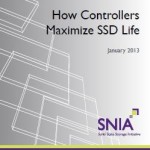An Israeli start-up named Kaminario is attacking Texas Memory Systems’ home turf with a DRAM SSD that offers speeds as fast as 1.5 million IOPS. While TMS has built itself a comfortable niche business using custom hardware, Kaminario’s K2 SSD, announced on June 16, is made using standard off-the-shelf low-profile blade servers from Dell. Only the software is proprietary.
DRAM SSDs are an interesting product that serves niches which flash SSDs are unlikely to penetrate. Objective Analysis’ new report on Enterprise SSDs explores the price and speed dynamics that separate these two technologies. See the Objective Analysis Reports page for more information.
Some of the K2’s internal servers are dedicated to handling I/O, and are called “io Directors.” The bandwidth of the storage system scales linearly with the number of io Directors used – a pair of io Directors provides 300K IOPS, and ten io Directors will support 1.5M IOPS. Below the io Directors are other servers called “Data Nodes” which manage the storage. Capacity scales linearly with the addition of Data Nodes. Today’s limit is 3.5TB, but this number will increase over time.
Redundancy is a key feature of the Kaminario K2: There are at least two of any device: io Directors, Data Nodes, and HDDs per Data Node, since the DRAM-based data is stored onto HDDs in the event of an unexpected power failure. The system can communicate with the host through a range of interfaces, with FCOE offered at introduction.
Kaminario’s K2 boasts a significantly smaller footprint and price tag than HDD-based systems with competing IOPS levels.
To find out more about Kaminario visit Kaminario.com
 SNIA’s SSSI has introduced a new booklet: How Controllers Maximize SSD Life. This 20-page volume, which can be downloaded as a pdf for free from the SNIA website, is a compilation of a series of blog posts on the SSD Guy blog.
SNIA’s SSSI has introduced a new booklet: How Controllers Maximize SSD Life. This 20-page volume, which can be downloaded as a pdf for free from the SNIA website, is a compilation of a series of blog posts on the SSD Guy blog.